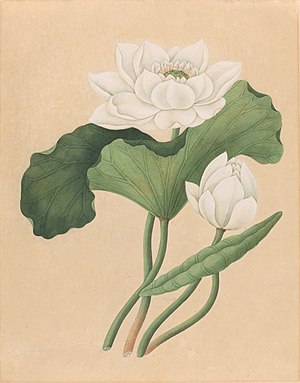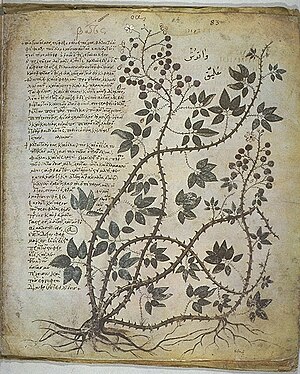Botanical illustration

Botanical illustration is the art of depicting the form, color, and details of plant species, frequently in watercolor paintings. They must be scientifically accurate but often also have an artistic component and may be printed with a botanical description in books, magazines, and other media or sold as a work of art.[2] Often composed by a botanical illustrator in consultation with a scientific author, their creation requires an understanding of plant morphology and access to specimens and references.
Typical illustrations are in watercolour, but may also be in oils, ink or pencil, or a combination of these. The image may be life size or not, the scale is often shown, and may show the habit and habitat of the plant, the upper and reverse sides of leaves, and details of flowers, bud, seed and root system.
Botanical illustration is sometimes used as a type for attribution of a botanical name to a taxon. The inability of botanists to conserve certain dried specimens, or restrictions on safe transport, have meant illustrations have been nominated as the type for some names. Many minute plants, which may only be viewed under a microscope, are often identified by an illustration to overcome the difficulties in using slide mounted specimens. The standards for this are by international agreement (Art 37.5 of the Vienna Code, 2006).
History
This section needs additional citations for verification. (October 2021) |


Early herbals and pharmacopoeia of many cultures have included the depiction of plants. This was intended to assist identification of a species, usually with some medicinal purpose. The earliest surviving illustrated botanical work is the Codex vindobonensis. It is a copy of Dioscorides's De Materia Medica, and was made in the year 512 for Juliana Anicia, daughter of the former Western Roman Emperor Olybrius.[3] The problem of accurately describing plants between regions and languages, before the introduction of taxonomy, was potentially hazardous to medicinal preparations. The low quality of printing of early works sometimes presents difficulties in identifying the species depicted.
When systems of botanical nomenclature began to be published, the need for a drawing or painting became optional. However, it was at this time that the profession of botanical illustrator began to emerge. The finer detail of the printing processes, greatly improving in the eighteenth century, allowed artists such as Franz and Ferdinand Bauer to depict the minute aspects of the subject. Illustrations became more accurate in colour and detail. The increasing interest of amateur botanists, gardeners, and natural historians provided a market for botanical publications; the illustrations increased the appeal and accessibility of these to the general reader. The use of exploded details would further illustrate the description given in the accompanying text. These details allowed a non scientific audience to go some way in identifying the species, the widening interest in natural history and horticulture was an inducement to the production of many floras and regular publications.
The field guides, floras, catalogues and magazines produced since this time have continued to include illustrations. The development of photographic plates has not made illustration obsolete, despite the improvements in reproducing photographs in printed materials. A botanical illustrator is able to create a compromise of accuracy, an idealized image from several specimens, and the inclusion of the face and reverse of the features such as leaves. Additionally, details of sections can be given at a magnified scale and included around the margins around the image.
Botanical illustration is a feature of many notable books on plants, a list of these would include:
Many books and publication continued to use illustrators even after printed matter began to incorporate photography. It would be many years before the colour printing would equal the illustrators plates. The accuracy and craft of the illustrators had developed in tandem with the botanists concerned, the work came to be accepted as important to the botanists and their institutions. The illustrated publication, Curtis's Botanical Magazine (1787), was to eventually appoint an official artist. The 230-year-old magazine, long associated with the Linnaean Society and Kew Gardens, is now primarily one of finer botanical illustration. A stream of the finest illustrators to appear in print have been featured in the magazine.
The contribution of botanical illustrators continues to be praised and sought and very fine examples continue to be produced. In the 1980s, Celia Rosser undertook to illustrate every Banksia species for the masterwork, The Banksias. When another species was described after its publication, Banksia rosserae, it was named to honour her mammoth accomplishment. Other illustrators, such as the profuse Matilda Smith, have been specifically honoured for this work. In 1972 the Smithsonian Institution hired its first botanical illustrator, Alice Tangerini.[4]
Recently, a renaissance has been occurring in botanical art and illustration. Organizations devoted to furthering the art form are found in the US (American Society of Botanical Artists), UK (Society of Botanical Artists), Australia (Botanical Art Society of Australia), and South Africa (Botanical Artists Association of South Africa), among others. The reasons for this resurgence are many. In addition to the need for clear scientific illustration, botanical depictions continue to be one of the most popular forms of "wall art".[5] There is an increasing interest in the changes occurring in the natural world and in the central role plants play in maintaining healthy ecosystems. A sense of urgency has developed in recording today's changing plant life for future generations. Working in media long understood provides confidence in the long-term conservation of the drawings, paintings, and etchings. Many artists are drawn to more traditional figurative work, and find plant depiction a perfect fit. Working with scientists, conservationists, horticulturists, and galleries locally and around the world, today's illustrators and artists are pushing the boundaries of what has traditionally been considered part of the genre.[6]
Notable botanical illustrators
Notable botanical illustrators include:
- James Andrews
- George French Angas
- Claude Aubriet
- Alois Auer
- Françoise Basseporte
- Ferdinand Bauer
- Franz Bauer
- Elizabeth Blackwell
- Harry Bolus
- Priscilla Susan Bury
- Olivia Marie Braida-Chiusano
- Mark Catesby
- Lise Cloquet
- Gillian Condy
- Léon Camille Marius Croizat
- Dioscorides
- Catharina Helena Dörrien
- Atanasio Echeverria y Godoy
- Sydenham Edwards
- Georg Dionysius Ehret
- James Henry Emerton
- Barbara Everard
- Walter Hood Fitch
- Barbara Jeppe
- Martha King
- Jacques le Moyne
- Dorothy van Dyke Leake
- Cythna Letty
- Carl Axel Magnus Lindman
- Margaret Mee
- Maria Sibylla Merian
- Philippa Nikulinsky
- Marianne North
- Pierre-Joseph Redouté
- Sarah Rhodes
- Lewis Roberts
- Celia Rosser
- Ellis Rowan
- Vera Scarth-Johnson
- Dorothea Eliza Smith
- Matilda Smith
- Lilian Snelling
- Gerard van Spaendonck
- James Sowerby
- Sydney Parkinson
- Alice Tangerini
- Frances Elizabeth Tripp
- Elizabeth Twining
- Pierre Jean François Turpin
- Ellaphie Ward-Hilhorst
The Linnaean Society of London awards the Jill Smythies Award for botanical illustration.[7]
See also
- Florilegium
- List of florilegia and botanical codices
- List of American botanical illustrators
- List of Australian botanical illustrators
- List of Irish botanical illustrators
- Illustration
- Stuttgart Database of Scientific Illustrators
References
- ^ "American Turk's cap Lily". Victoria and Albert Museum. Retrieved 2007-12-12.
- ^ Sydney Living Museums (2016-07-13), The art in the illustration, archived from the original on 2021-12-21, retrieved 2016-07-29
- ^ "Kew Gardens website".
- ^ Corson, Cheryl (March 9, 2017). "Botanical Illustrator Alice Tangerini". Hill Rag. Capital Community News Inc. Retrieved July 6, 2017.
- ^ Antique botanical illustrations for use as home decor at Fine Rare Prints
- ^ Ultimate Guide To Wall Art
- ^ "Linnean Society Medals, Awards, Prizes and Grants". Retrieved 16 October 2021.
Further reading
- De Bray, Lys (2001). The Art of Botanical Illustration: A history of classic illustrators and their achievements. Quantum Publishing, London. ISBN 1-86160-425-4.
- Blunt, Wilfrid and Stearn, William T. (1994). The Art of Botanical Illustration. Antique Collector's Club, London. ISBN 1-85149-177-5.
- Morris, Colleen; Louisa Murray: (2016). The Florilegium: the Royal Botanic Gardens Sydney celebrating 200 years: plants of the three gardens of the Royal Botanic Gardens and Domain Trust, The Florilegium Society at the Royal Botanic Gardens, Sydney. ISBN 978-099-447790-3
- Sherwood, Shirley (2001). A Passion for Plants: Contemporary Botanical Masterworks. Cassell and Co, London. ISBN 0-304-35828-2.
- Sherwood, Shirley and Rix, Martyn (2008). Treasures of Botanical Art. Royal Botanic Gardens, Kew. ISBN 978-1-84246-221-8.
- "Index". Australian Plant Collectors and Illustrators 1780s-1980s. Australian National Herbarium. Retrieved 2008-10-02.
- "Women Illustrators". The Art of Botanical Illustration. University of Delaware Library. Retrieved 2008-10-02.
- "Home page". Hunt Institute for Botanical Documentation. Carnegie Mellon University. Archived from the original on 2008-05-09. Retrieved 2008-10-02.
- Lack, H. Walter (2021). A Garden Eden: Masterpieces of Botanical Illustration. Taschen. ISBN 978-3-8365-7739-7.
External links
- American Society of Botanical Artists
- Art Serving Science: Solutions for the Preservation and Access of a Collection of Botanical Art and Illustration
- Botanical Art Society of Australia
- Botanical Drawings of carnivorous plants from the John Innes Centre Historical Collection
- Plantillustrations.org: searchable database of historic illustrations
- Botany.si.edu: online Smithsonian catalogue
- Flora of New Granada (Colombia) Drawings online, from the Royal Botanical Expedition led by Jose Celestino Mutis
- Traveling Artist Wildflowers Project
- University of Delaware: 'The Art of Botanical Illustration' exhibit


